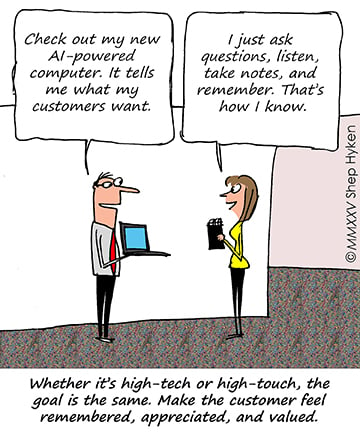 The concept of personalization is gaining increased attention. My annual customer experience research found that nearly eight out of 10 customers (79%) in the U.S. feel a personalized experience is important. So, what is a personalized experience?
The concept of personalization is gaining increased attention. My annual customer experience research found that nearly eight out of 10 customers (79%) in the U.S. feel a personalized experience is important. So, what is a personalized experience?
It’s simple. Using a customer’s data and information (with their permission, of course), which could include preferences they’ve shared with you, past behaviors, purchasing patterns, notes from interactions they’ve had with you and more, allows you to tailor interactions, offers, and communications to the customer based on what you know about them.
It also allows you to group customers into segments. For example, if you sell shoes and a customer has bought three pairs of golf shoes in the past year, you wouldn’t recommend running shoes. However, you might inform the customer, and customers like him, about the latest golf shoe technology and suggest other golf-related products. This personalized experience results in customers feeling recognized and valued, rather than just being treated as a generic transaction.
Now, there’s a higher level of personalization, and that’s individualization. Personalization makes customers feel recognized. Individualization makes them feel truly understood. This next level of personalization comes from the amount of data that can be collected from an individual customer, combined with AI’s ability to interpret that data with uncanny accuracy. The best way to describe the difference is that it’s no longer about customer segmentation. It’s about providing truly individualized experiences tailored to each customer.

Why is this important to the customer experience? If you thought personalization made a customer feel recognized and valued, this is that on steroids.
Old-fashioned individualization before AI was the amazing salesperson who always recognized you, remembered what you bought, knew what you liked, could predict what you’d want to buy and might even call you to let you know that your favorite brand had something new that you’d love.
Modern individualization is when you log into Amazon and the website welcomes you, not just promoting the brand of toothpaste you’ve bought in the past, but also reminding you that you may be running low on toothpaste.
And even though AI is making individualization easier, you don’t need expensive AI software to do this. You can start by paying attention. One of my clients is a master at sending out birthday cards with hand-written, individualized messages. And when you call him, he remembers details about you. It’s not magic or AI software. It’s just asking questions, listening to the answers and taking notes so he remembers the details the next time he talks to the client.
The goal is to make every customer feel like they are your only customer. Whether you’re using AI or just old-fashioned attention to detail, the result is the same. Done the right way, customers feel valued and appreciated and respond by saying, “I’ll be back!”








